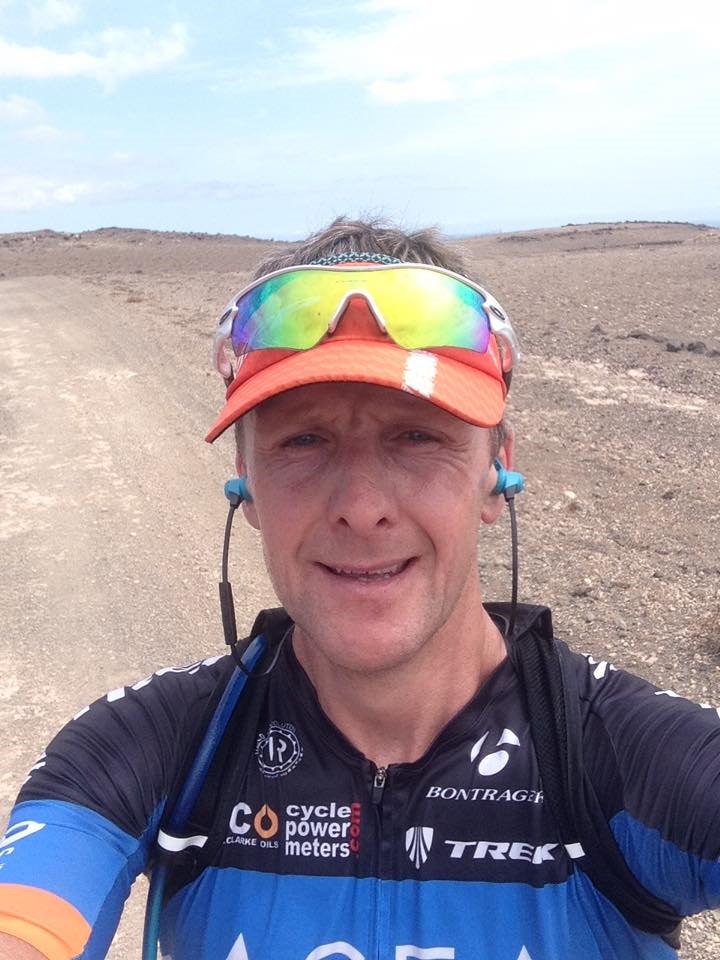What separates Kona qualifiers?
Alan Couzens, M.Sc. (Sports Science)
Sept 13th, 2016

The pic on the left is of Owen Martin (one of the speedy Age Groupers that I work with) doing #WhatItTakes year after year to qualify. In this case, a massive week of training in Lanzarote. Owen is a good example of what separates the guys who qualify from those who don’t. He is someone who consistently gets the work done & (providing the Irish rain isn’t too persistent :-) has a lot of fun doing it! So, that inevitably brings us to the question, how much work?
Every year around this time, I do a bit of an annual round up of the guys on my squad who qualify for the World Championships in Kona. This year, I also pulled the non-qualifiers so I could do a bit of a ‘compare and contrast’. Some key stats from that analysis are shown in the table below…
Note: I had some rogue pro data in my non kona numbers in my twitter post which is why the numbers are slightly different here. Message – scrub your data :-)

Key points…
- Training volume is obviously significantly higher among the qualifying group. Almost double that of the non-qualifiers, averaging around about 17hrs a week, (~2.5hrs/day of training). In a more real word sense - '2 a days', most days, through the year are the norm for the guys/gals who secure a slot. This can sound like a big commitment in a sport that mixes the competitive and the recreational but, in reality, '2 a days' are pretty standard for serious competitive athletes in most sports.
- The above withstanding, there is a large range of what constitutes 'high volume' among qualifiers, with a standard deviation of over 200hrs, i.e. some folks, for whatever reason, have the genetic raw material to qualify on ~650hrs of training load. For others, it will take over a thousand hours. Choose your parents wisely and all that. That said, I can only recall 1 athlete in my history of coaching who trained a 1000+hr year and didn’t qualify (and he did qualify off that base the following year). Given the time commitment & a bit of persistence, a Kona slot is a realistic possibility for just about everyone.
- There isn't much difference in the overall intensity of training for both groups, with an average intensity factor (I.F.) right around the aerobic threshold (IF of ~0.7). This is deliberate and indicative of the importance I place on establishing an aerobic base. In my experience, this is a good bit lower than most self coached athletes train & is also a good bit below race intensity for most of the speedy group.
- I also included the bike and run efficiency factor numbers (avg power and pace divided by HR) so you can get a better idea of the aerobic fitness numbers that these training loads yield for the 2 groups. Basically, 1.7 on the bike and at least 1.5 on the run is the level of fitness required to get a slot these days for an average size male athlete (with average HR max), i.e. 240W at 140bpm and ~7:30/mi at 140bpm on the run.
- I pulled BMI data just to indicate that you can’t starve yourself to a slot. Yes, KQers are leaner than average but not ridiculously skinny. An important reminder that Ironman is, fundamentally, a strength-endurance event that demands some 'reserve'.
- Training response (k1) (which you can read more about here): There is a perception among some circles that you need to be ‘gifted’ to qualify, i.e. only the highest responders to training need apply. My data would disagree with that and suggest that KQers actually on average get less fitness bang per training buck than non qualifiers. This is no doubt partially due to the ‘blunting’ of response that occurs at high training loads but it shows nevertheless that the difference is the absolute work done, not a genetically high response to work.
- Finally, I averaged the minimum & maximum volume months for the qualifiers & non-qualifier groups. A couple of things are clear – both still include a big range of volume in their annual prep, i.e. they take their (relative) rest periods after peak load and then progressively ramp back up. Probably because they have a coach who is insistent on holding them back in the early season :-) For the KQers, this makes for some very big training months at key periods in the year! Generally, these exceed the limits of a regular 9-5 and necessitate some ‘getaway’ training camps as illustrated by Owen in the pic above :-) In my opinion, these pre-race camps are quickly becoming an essential ingredient for those serious about getting a slot.
I’m sharing these numbers because we’re in that magical period of the year - #DreamingSeason (as coined by the Training Peaks crew) We’re 12+ months out from Kona 2017 and, I’m hoping that the above shows that, with sufficient life space, a commitment to putting in the work and an intelligent plan, the possibility of a KQ slot is not a dream but an entirely possible goal – a challenging one admittedly but isn't that the point? The magic of the Kona quest is that it is a true challenge. Possible for all but achieved by so very few. Are you up for it?
Train smart,
AC
TweetDon't miss a post! Sign up for my mailing list to get notified of all new content....
